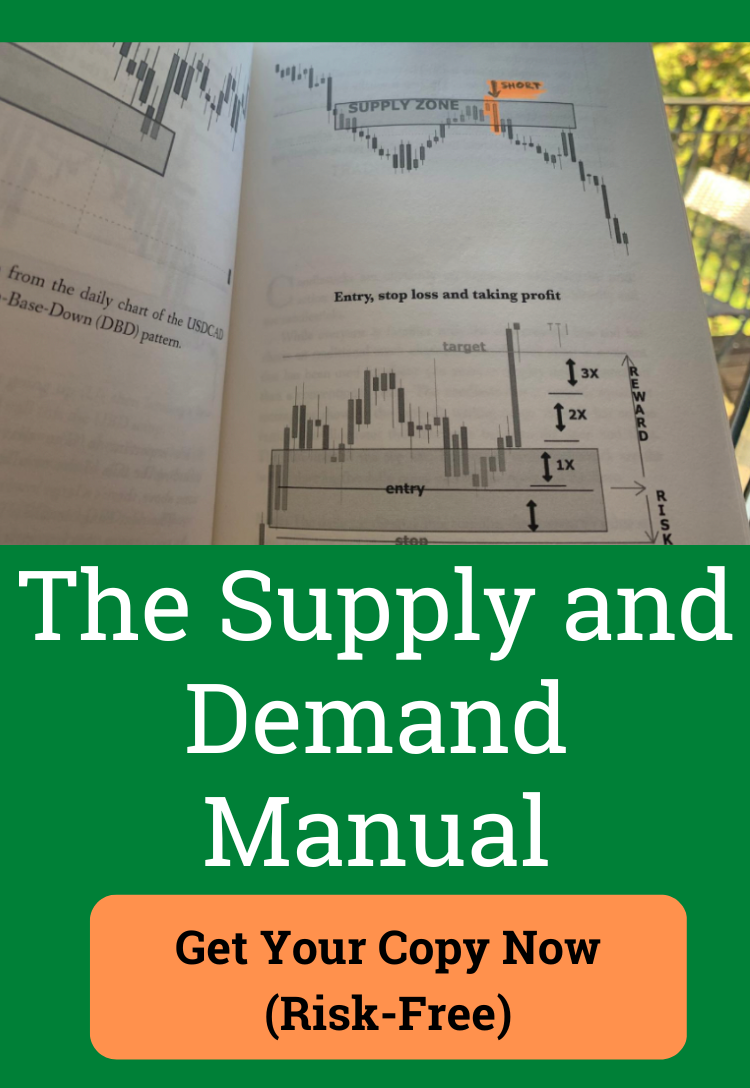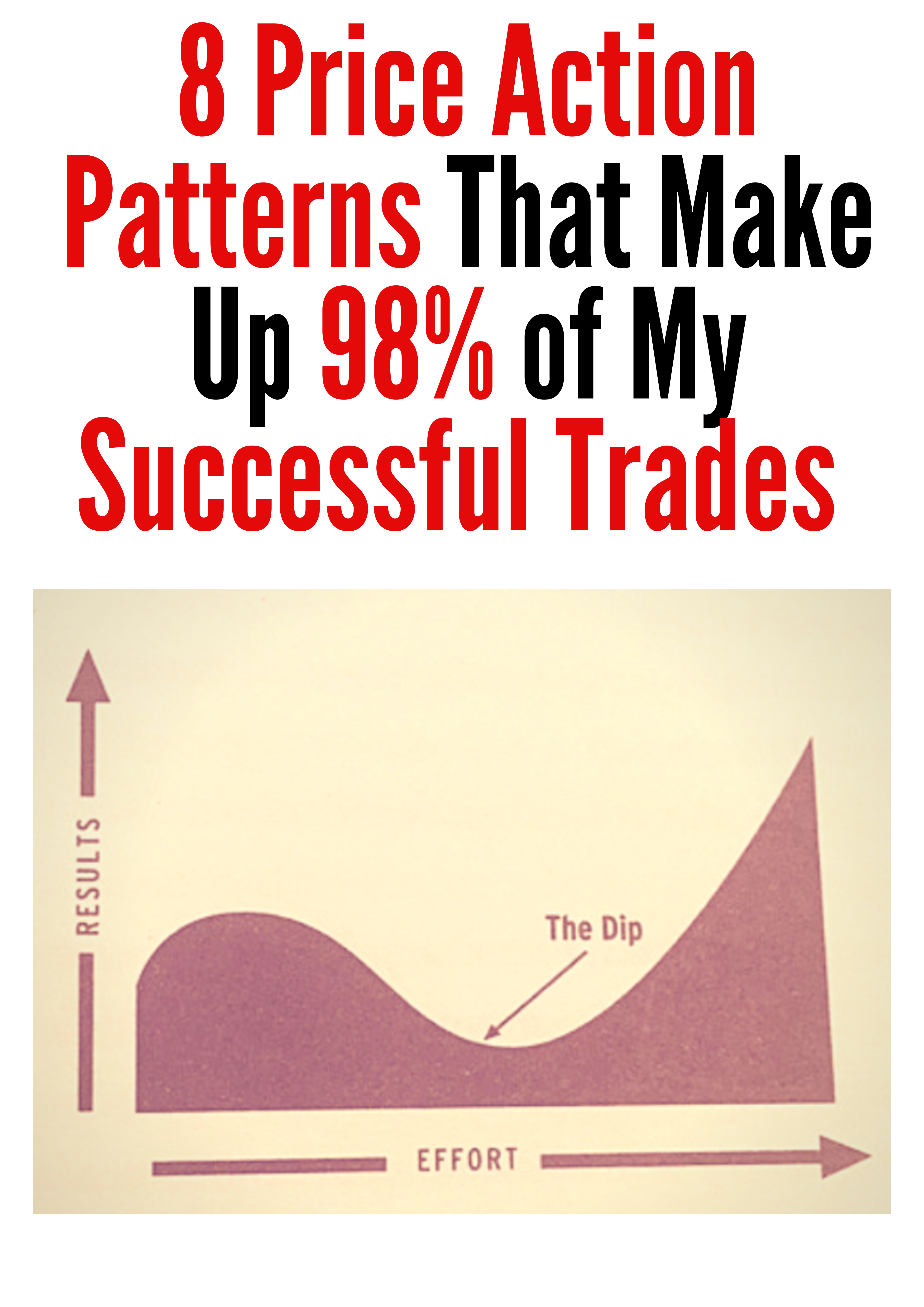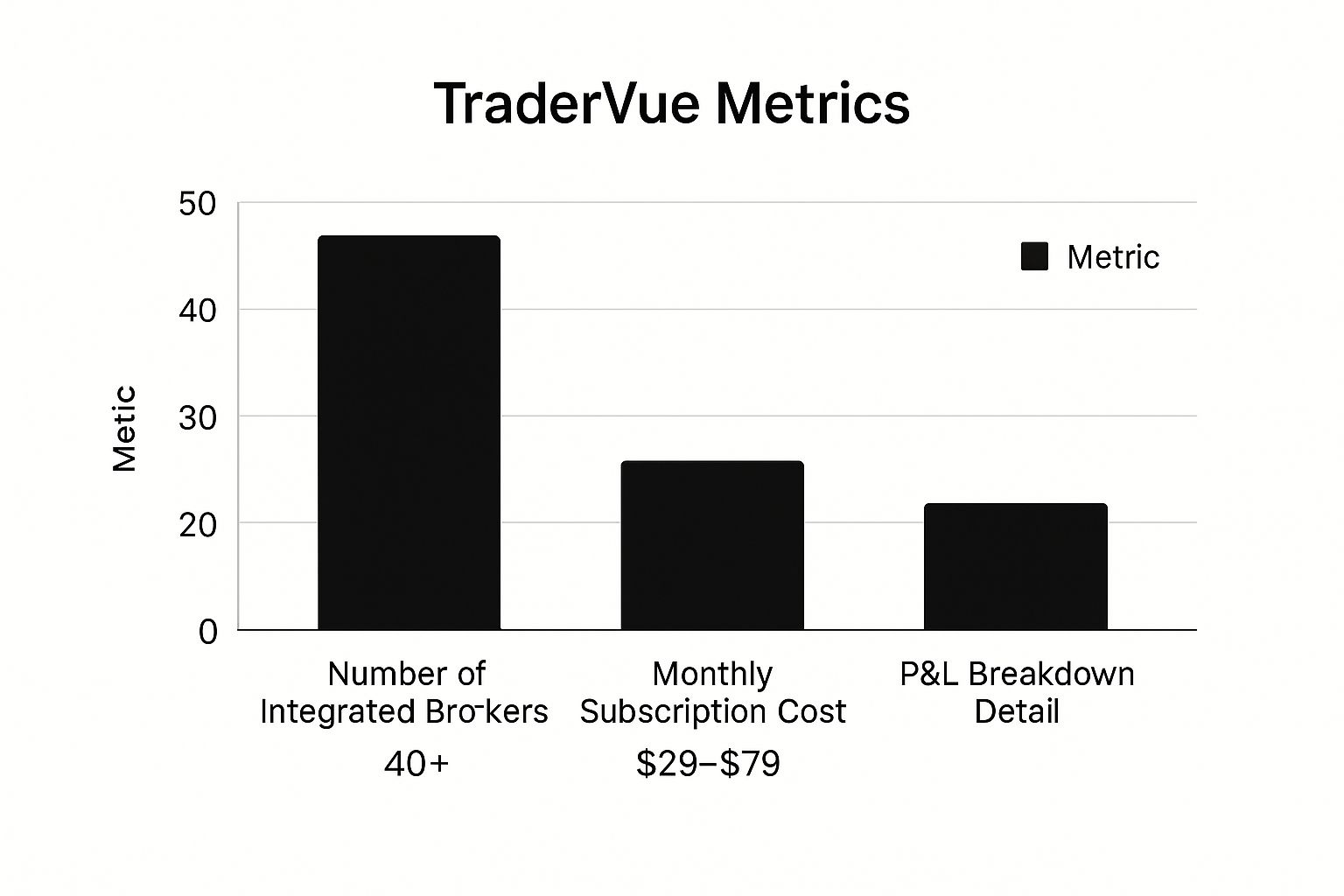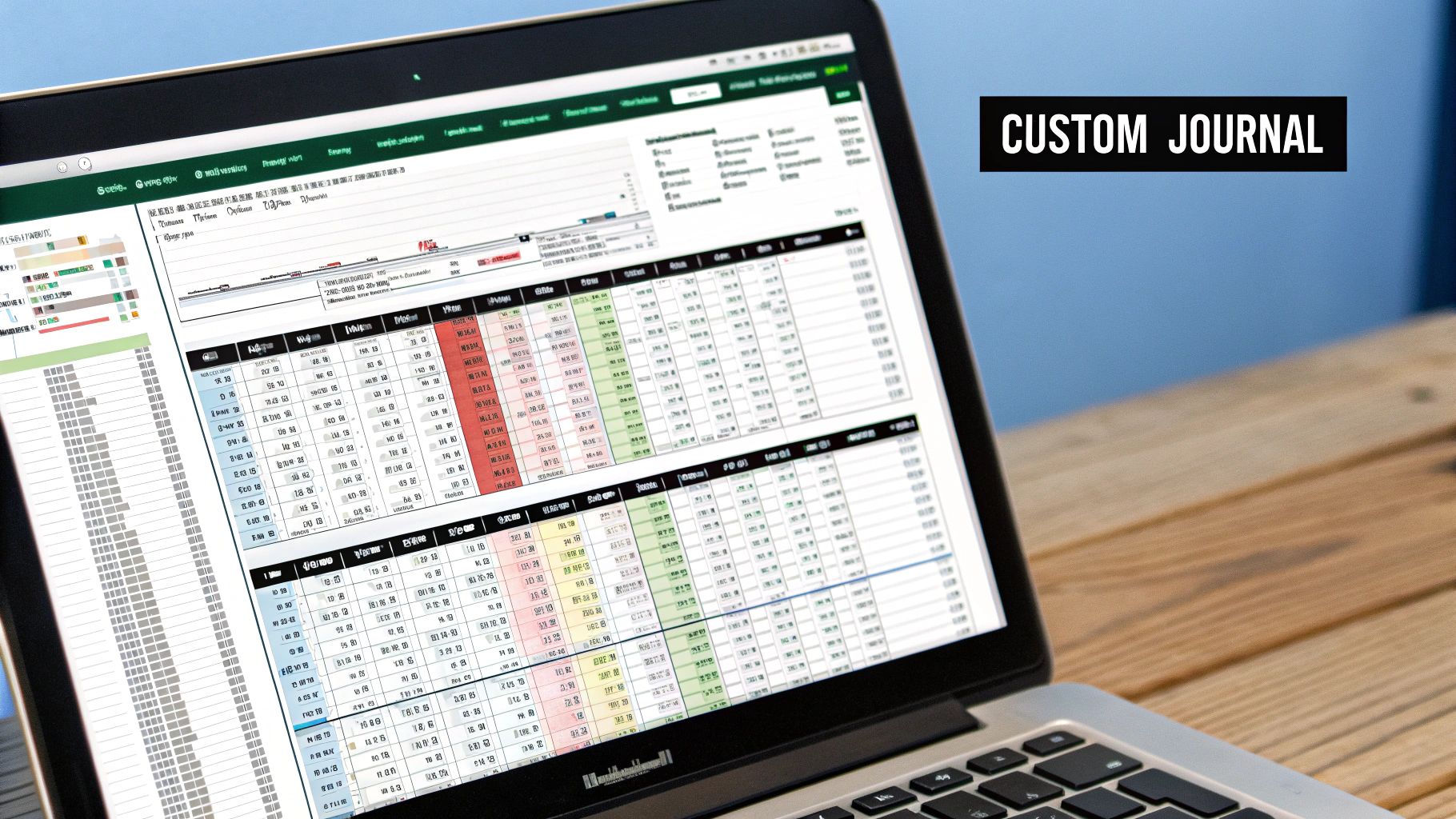6 Trading Journal Examples: Enhance Your Trading in 2025
Unlock Your Trading Potential: Why a Trading Journal Matters
A trading journal is more than a record of wins and losses; it's a roadmap to consistent profitability. It's the key to understanding your trading behavior, identifying strengths, and eliminating weaknesses. This listicle provides six diverse trading journal examples, offering actionable insights to elevate your trading. We'll analyze each example like a strategist, dissecting the "why" behind successful (and unsuccessful) trades. You'll learn how to extract tactical insights and replicate winning strategies. Whether you're using simple spreadsheets or sophisticated software, a well-maintained journal transforms your trading approach.
This article explores several popular trading journal examples:
- TraderVue
- Edgewonk Trading Journal
- TradingDiary Pro
- Excel/Google Sheets Custom Trading Journal
- MyFXBook Trading Journal
- TradersSync
We'll delve into specific features and provide actionable takeaways for each example. You’ll discover how each journal can be customized to fit your unique trading style. Find the perfect trading journal example and unlock your trading potential through meticulous tracking and in-depth analysis. No matter your experience level, learn to leverage the power of a trading journal to consistently improve your performance. From identifying emotional biases to refining your entry and exit strategies, trading journal examples provide a framework for consistent growth.
1. TraderVue
TraderVue stands out as a premier cloud-based trading journal and performance analytics platform. Designed for traders of all skill levels, it simplifies the often-overlooked but crucial task of journaling. Its core function is to help traders track, analyze, and ultimately improve their trading performance by offering in-depth insights into their strengths and weaknesses. This makes it an invaluable tool for identifying patterns, refining strategies, and achieving consistent profitability.
How TraderVue Works
The platform's strength lies in its automated trade importing from major brokers, eliminating manual entry and ensuring data accuracy. This automation saves traders valuable time and reduces the risk of errors. TraderVue then processes this raw trade data into comprehensive statistics, charts, and detailed performance metrics. This allows traders to visualize their trading history and identify recurring patterns, both positive and negative. By understanding these patterns, traders can refine their strategies and make more informed decisions.
Real-World Applications
TraderVue caters to diverse trading styles, with examples including:
- Day Traders: Analyzing win rates across different market conditions to optimize intraday strategies.
- Swing Traders: Tracking performance by sector and time held to identify the most profitable holding periods.
- Options Traders: Monitoring Greeks and implied volatility (IV) analysis to manage risk and identify opportunities.
- Forex Traders: Analyzing currency pair performance to pinpoint favorable trading setups.
These varied applications demonstrate TraderVue's versatility and adaptability to diverse trading approaches. Its ability to segment data by asset class, strategy, and time frame provides granular insights for specific trading styles.
Actionable Tips for Using TraderVue
To maximize the benefits of TraderVue, consider these tips:
- Set up automatic imports immediately: This avoids data gaps and ensures a complete trading history.
- Use tags consistently: Categorize trades by strategy (e.g., scalping, swing trading) for focused analysis.
- Review weekly and monthly reports: Identify patterns and trends in your trading performance over time.
- Utilize the notes feature: Record market conditions and your reasoning behind each trade for later review.
- Share reports with mentors or trading groups: Gain valuable feedback and identify blind spots in your strategy.
Why TraderVue Deserves Its Place on the List
TraderVue earns its spot on this list due to its comprehensive features, automation capabilities, and focus on data-driven analysis. It moves beyond simple trade logging to provide actionable insights that can significantly impact trading performance. The platform's popularity among professional trading educators, online communities, and broker recommendations further solidifies its value.
The following infographic visualizes key data about TraderVue, including the number of integrated brokers, the monthly subscription cost range, and the profit and loss (P&L) breakdown detail.
The bar chart clearly shows TraderVue’s broad broker integration (40+), its accessible pricing ($29-$79 monthly), and a deep level of P&L analysis, highlighting its value proposition for traders of all levels. These factors, combined with its intuitive interface and robust analytical tools, make TraderVue a powerful tool for any serious trader looking to enhance their performance.
2. Edgewonk Trading Journal
Edgewonk is a comprehensive desktop trading journal software that focuses on detailed trade analysis and trader psychology. Designed to help traders identify their "edge" in the market, it offers extensive statistical analysis, performance tracking, and behavioral pattern recognition. The platform uniquely emphasizes the psychological aspects of trading alongside traditional performance metrics, making it a powerful tool for enhancing trading consistency and profitability. Learn more about using Edgewonk in conjunction with backtesting your trading strategy. Learn more about…
How Edgewonk Works
Edgewonk allows manual trade entry, ensuring compatibility with various trading instruments and strategies. The software then analyzes this data, presenting it in visually appealing charts and graphs. These visualizations highlight key performance indicators, including win rate, average win/loss ratio, and expectancy. Furthermore, Edgewonk’s unique psychological tracking features allow traders to log their emotional state before, during, and after each trade, providing crucial insights into how emotions impact trading decisions.
Real-World Applications
Edgewonk's flexibility makes it a valuable tool for diverse trading styles:
- Professional Prop Traders: Use detailed performance analysis to refine strategies and manage risk within a structured trading environment.
- Swing Traders: Track psychological states during winning and losing streaks to understand emotional influences on trading decisions.
- Scalpers: Analyze minute-by-minute performance patterns to optimize entry and exit points for rapid trades.
- Trading Coaches: Leverage Edgewonk to mentor students by providing personalized feedback based on detailed trade data and psychological insights.
These applications demonstrate Edgewonk's versatility in catering to a wide range of trading approaches and experience levels.
Actionable Tips for Using Edgewonk
Maximize the benefits of Edgewonk with these practical tips:
- Start with basic metrics: Focus on core performance indicators before delving into advanced features.
- Consistently log emotional state: Record your mindset before, during, and after trades to identify psychological patterns.
- Use screenshot features: Review trade setups to assess their quality and identify areas for improvement.
- Set specific, measurable goals: Leverage the goal-tracking feature to monitor progress and maintain focus.
- Regularly review correlation reports: Identify connections between your trading performance and various factors, like market conditions and emotional state, to discover your unique edge.
Why Edgewonk Deserves Its Place on the List
Edgewonk stands out as a "trading journal examples" contender due to its in-depth analytical tools and focus on trader psychology. Its comprehensive approach, combined with robust reporting features, empowers traders to gain a deeper understanding of both their trading performance and psychological influences. This combination is crucial for long-term success in the markets, and the emphasis on self-awareness makes Edgewonk a valuable tool for traders seeking consistent profitability.
3. TradingDiary Pro
TradingDiary Pro distinguishes itself as professional-grade trading journal software. It combines comprehensive trade tracking with advanced portfolio management features. Designed for active traders, it addresses the need for detailed record-keeping for tax purposes, performance analysis, and regulatory compliance. The platform’s versatility extends to supporting multiple account types and various asset classes, making it a robust solution for serious traders.
How TradingDiary Pro Works
TradingDiary Pro centers around meticulously recording every trade detail. This includes entry and exit points, trade size, dates, and associated fees. The software then leverages this data to generate in-depth performance reports. These reports encompass key metrics like profit/loss, win rate, average trade duration, and maximum drawdown. This detailed analysis allows traders to pinpoint strengths and weaknesses in their trading approach and make data-driven adjustments.
Real-World Applications
TradingDiary Pro’s advanced features cater to demanding trading scenarios, such as:
- Hedge Fund Managers: Tracking multiple strategies across diverse portfolios, providing a consolidated view of performance.
- Professional Traders: Managing complex tax obligations across numerous accounts, simplifying reporting and compliance.
- Financial Advisors: Monitoring client trading performance and generating comprehensive reports for review and discussion.
- Active Traders: Analyzing complex options and futures strategies, gaining insights into the effectiveness of each approach.
These varied applications demonstrate the software’s adaptability to different trading styles and complexities.
Actionable Tips for Using TradingDiary Pro
To optimize the use of TradingDiary Pro and extract maximum value, consider these tips:
- Invest time in proper initial setup: Ensure accurate tracking from the start by configuring account details and asset classes correctly.
- Utilize custom categories for different trading strategies: Segment your trades for granular analysis of individual strategies.
- Regularly backup your trading data: Protect your valuable trading history and safeguard against data loss.
- Use benchmark comparisons to evaluate relative performance: Assess your trading performance against relevant market benchmarks to gain perspective.
- Take advantage of training resources and webinars: Master the platform's features and learn best practices from experts.
Why TradingDiary Pro Deserves Its Place on the List
TradingDiary Pro earns its place on this list because it addresses the complex needs of serious traders. Its comprehensive features, including detailed record-keeping, advanced portfolio management, and regulatory compliance support, set it apart. The platform's adoption by financial institutions, professional money managers, and tax professionals speaks to its value and reliability. It moves beyond basic trade logging to become an essential tool for performance analysis, risk management, and strategic decision-making. These features, combined with its robust reporting capabilities, make TradingDiary Pro a valuable asset for any trader seeking to optimize their performance and manage their trading business effectively. This comprehensive approach to trading journaling solidifies TradingDiary Pro's position as a top choice for traders who demand accuracy and detailed analysis.
4. Excel/Google Sheets Custom Trading Journal
An Excel/Google Sheets custom trading journal represents the most flexible and cost-effective approach to trade tracking for serious traders seeking examples. This method involves creating personalized spreadsheets with formulas, charts, and data validation to track trades, calculate performance metrics, and analyze trading patterns. It's highly customizable and can be tailored to any trading style or strategy, making it a powerful tool for maximizing profits.
How Excel/Google Sheets Journals Work
The power of a custom spreadsheet lies in its adaptability. Beginning traders can start with simple win/loss tracking and basic calculations. More experienced traders can create complex dashboards incorporating multiple strategies, advanced statistical analysis, and even integrate with brokerage APIs for automated data imports. This scalability allows the journal to evolve with the trader's skill and experience.
Real-World Applications
The versatility of custom spreadsheets is reflected in their diverse applications among traders looking for practical trading journal examples:
- Beginning Traders: Tracking win/loss ratios and average profit/loss per trade to understand basic performance metrics.
- Experienced Traders: Building dashboards to visualize performance across different asset classes, strategies, and timeframes.
- Trading Groups: Sharing standardized templates to ensure consistent data collection and facilitate collaborative analysis.
- Traders integrating journal data with business accounting: Streamlining tax reporting and financial management.
Actionable Tips for Using Excel/Google Sheets
To effectively use this method, consider these tips:
- Start simple and gradually add complexity: Avoid overwhelming yourself with advanced features initially.
- Use data validation to prevent input errors: Ensure data accuracy for reliable analysis.
- Create backup copies regularly: Protect your valuable trading data.
- Utilize conditional formatting for quick visual insights: Highlight key performance indicators.
- Consider Google Sheets for cloud access and collaboration: Enable seamless access and team sharing. Learn more about… helpful templates and resources.
Why Excel/Google Sheets Deserve Their Place on the List
Custom spreadsheets earn their place on this list of trading journal examples because of their unmatched flexibility, affordability, and accessibility. They empower traders to tailor their journals to their specific needs and evolve their tracking as their skills develop. The widespread availability of resources, templates, and online communities further strengthens the value proposition of this approach, making it a compelling choice for traders of all levels.
5. MyFXBook Trading Journal
MyFXBook distinguishes itself as a prominent online platform primarily designed for forex traders. It offers a comprehensive suite of tools, including automated trade tracking, social trading features, and in-depth performance analysis. Connecting directly to MT4/MT5 accounts, MyFXBook automatically records trading activity in real-time, eliminating manual data entry and offering valuable insights into trading behavior. The platform also fosters a community aspect, allowing traders to share and compare their performance, promoting learning and collaboration within the forex trading world.
How MyFXBook Works
MyFXBook's strength lies in its seamless integration with popular trading platforms like MT4/MT5. This connection allows for automatic trade importing, ensuring accuracy and saving traders considerable time. The platform then processes this raw trade data into visually appealing charts, graphs, and key performance indicators (KPIs). These visualizations make it easy to identify trends, analyze trading patterns, and assess the overall effectiveness of a trading strategy. The social trading feature further enhances its value by enabling traders to learn from others and potentially replicate successful strategies.
Real-World Applications
MyFXBook's versatile features cater to a variety of trading styles and objectives, with examples including:
- Forex Traders: Analyzing performance across different currency pairs to identify strengths and weaknesses.
- Social Traders: Following and copying successful strategies from experienced traders within the community.
- Currency Traders: Tracking performance metrics like win rate, average profit/loss, and drawdown to refine strategies.
- Prop Trading Firms: Monitoring trader performance and risk management to ensure compliance and optimize returns.
These varied applications demonstrate MyFXBook's adaptability and relevance within the broader forex trading ecosystem. Its ability to connect with popular trading platforms and provide detailed performance analysis makes it a valuable tool for traders of all experience levels.
Actionable Tips for Using MyFXBook
To maximize the benefits of MyFXBook, consider implementing these tips:
- Verify your account: This builds credibility and allows you to participate fully in the community.
- Utilize privacy settings: Control the information shared publicly to protect your trading strategies.
- Review the economic calendar: Integrate fundamental analysis into your trading decisions for improved timing.
- Engage with the community: Learn from experienced traders and share your own insights.
- Monitor risk metrics closely: Avoid excessive drawdowns and maintain consistent risk management practices.
Why MyFXBook Deserves Its Place on the List
MyFXBook earns its spot on this list due to its automated tracking, comprehensive performance analysis, and vibrant social trading community. It offers a valuable platform for forex traders to not only track their trades but also learn from and interact with other traders. Its integration with MT4/MT5, combined with its focus on community and performance transparency, makes MyFXBook a powerful tool for any forex trader seeking to improve their performance.
6. TradersSync
TradersSync is a comprehensive trading journal and analytics platform built for active traders. Those who need detailed performance tracking across multiple brokers and asset classes will find it especially useful. It focuses on providing institutional-quality analytics and reporting tools. However, it maintains an intuitive user interface suitable for retail traders. This balance makes it a powerful tool for traders of all experience levels.
How TradersSync Works
TradersSync simplifies the process of aggregating trading data. It connects directly to multiple brokerage accounts, automatically importing trade history and eliminating manual entry. This automation ensures data accuracy and saves traders significant time. The platform then analyzes this data, generating key performance indicators (KPIs) and insightful visualizations. These metrics provide a clear picture of trading performance, enabling traders to identify strengths, weaknesses, and areas for improvement. Learn more about managing your trading risk with tools like TradersSync. Learn more about…
Real-World Applications
TradersSync's flexibility caters to a variety of trading styles and needs:
- Multi-asset traders: Track performance across stocks, options, and futures within a unified platform. This allows for a holistic view of portfolio performance and risk.
- Day traders: Analyze intraday performance patterns, including win rate, average win/loss size, and holding periods. This granular data facilitates strategy optimization.
- Risk managers: Monitor portfolio exposure and risk metrics across multiple accounts, helping to ensure consistent risk management practices.
- Trading teams: Collaborate on strategy performance analysis and share insights, promoting a data-driven approach to trading.
These examples highlight the platform’s versatility and adaptability to diverse trading approaches.
Actionable Tips for Using TradersSync
To maximize the value of TradersSync, consider these tips:
- Set up all broker connections during initial setup: This ensures complete data capture from the start and avoids gaps in your trading history.
- Use consistent tagging for strategy identification: This allows you to filter and analyze trades based on specific strategies, revealing their individual performance.
- Review risk metrics weekly to maintain discipline: Regularly monitoring key risk indicators helps you stay within defined risk parameters and avoid excessive losses.
- Utilize goal-setting features for motivation: Setting clear and achievable goals helps maintain focus and provides a benchmark for progress.
- Export data regularly for additional analysis: Leverage external tools for deeper dives into specific aspects of your trading performance.
Why TradersSync Deserves Its Place on the List
TradersSync's commitment to data-driven analysis, combined with its user-friendly interface and multi-broker support, earns it a place on this list. It empowers traders with the insights needed to refine strategies, manage risk effectively, and achieve consistent profitability. Its popularity within modern trading communities, particularly among multi-asset and risk-focused traders, speaks to its effectiveness.
Top 6 Trading Journal Tools Comparison
| Platform | Implementation Complexity 🔄 | Resource Requirements ⚡ | Expected Outcomes 📊 | Ideal Use Cases 💡 | Key Advantages ⭐ |
|---|---|---|---|---|---|
| TraderVue | Moderate; setup with auto-import, some learning curve | Cloud access, monthly subscription ($29-79) | Automated trade tracking; comprehensive performance metrics | Traders wanting automated tracking with minimal setup | Broker integrations; user-friendly; cloud-based access |
| Edgewonk Trading Journal | High; desktop install, manual data entry, steep learning curve | One-time purchase ($259); desktop only | Deep analytical insights; psychological tracking | Serious traders needing detailed analysis and psychology | Extensive metrics; lifetime updates; no subscriptions |
| TradingDiary Pro | High; complex setup for multi-account tracking | Annual license ($200-500); desktop-based | Professional-grade record-keeping; tax and compliance ready | Professional/institutional traders with complex portfolios | Multi-asset support; tax reporting; advanced benchmarking |
| Excel/Google Sheets Custom | Very High; fully custom build and manual maintenance | Low cost (free to $10/month); spreadsheet skills required | Flexible, fully customizable tracking and analytics | Traders wanting full control and customization | Unlimited customization; free/low cost; familiarity |
| MyFXBook Trading Journal | Low; auto-sync with MT4/MT5, minimal setup | Free basic version; premium starts $15/month | Real-time forex trade tracking; social trading features | Forex traders on MetaTrader platforms valuing social aspects | Automatic MT4/MT5 integration; social trading; free tier |
| TradersSync | Moderate; multi-broker setup, web app | Subscription ($19-49/month); cloud-based | Multi-asset analytics; risk management focus | Active traders needing multi-account analytics | Multi-broker support; risk metrics; modern UI |
Elevate Your Trading: Choosing the Right Journal
This exploration of trading journal examples, from streamlined platforms like TraderVue and TradingDiary Pro to adaptable solutions like Excel spreadsheets and MyFXBook integration, has highlighted the critical role of meticulous record-keeping in trading success. Each example offers unique features catering to different needs and trading styles. By examining these diverse approaches, we've uncovered key insights into how a well-structured journal can transform your trading performance.
Key Takeaways for Effective Journaling
Analyzing these trading journal examples reveals several crucial takeaways. Strategic analysis, not just data entry, is paramount. Understanding the why behind your trades, not simply the what, is what fuels improvement.
- Identify Your Needs: Consider your trading style, preferred markets, and technical analysis methods when selecting a journal. Do you need advanced charting integration? Or is a simpler, trade-focused approach sufficient?
- Consistency is Key: No journal, no matter how sophisticated, will be effective if it's not used consistently. Make journaling a non-negotiable part of your trading routine.
- Focus on Actionable Insights: Don't just record data; analyze it. Look for patterns in your wins and losses. Identify areas for improvement in your strategy and execution.
- Adapt and Evolve: Your trading journal should adapt as your trading style evolves. Regularly review and adjust your journal template to ensure it captures the most relevant information.
The Power of Personalized Insights
The true power of a trading journal lies in the personalized insights it provides. By diligently recording your trades, you unlock a wealth of data that can reveal your strengths, weaknesses, and areas for improvement. These insights allow you to refine your strategies, manage risk more effectively, and ultimately, make more informed trading decisions. Whether you're a novice trader learning the ropes or a seasoned professional fine-tuning your approach, a well-maintained trading journal is an indispensable tool.
Connecting Journaling to Price Action
For those following price action methodologies, like those taught by Colibri Trader, a trading journal becomes even more vital. Accurate record-keeping allows you to backtest your strategies against historical price data and refine your understanding of market dynamics. By meticulously documenting your entries, exits, and the rationale behind each trade, you can identify recurring patterns and refine your ability to read the market. This deep dive into your trading history provides the foundation for consistent profitability.
Looking at examples like Edgewonk and TradersSync, with their emphasis on performance metrics, reinforces the importance of tracking key statistics like win rate, average win/loss ratio, and risk/reward ratios. These metrics offer a quantifiable measure of your progress, allowing you to track improvements and identify areas requiring further attention. By combining the insights from your trading journal with the principles of price action, you empower yourself to make data-driven decisions and achieve consistent trading success.
Ready to take your trading to the next level? Colibri Trader provides comprehensive price action education and resources that seamlessly integrate with effective journaling practices. Visit Colibri Trader to discover how their proven methodologies can help you achieve consistent profitability in the markets.








